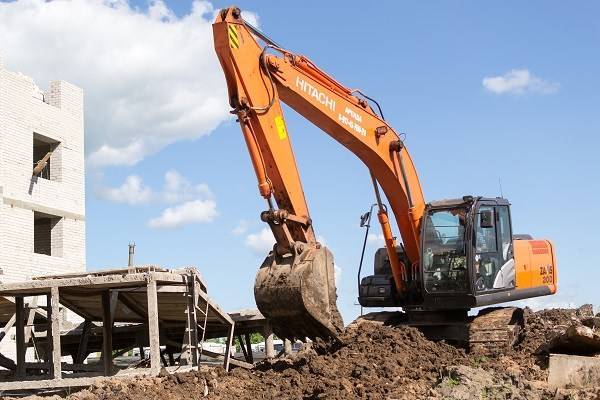
Where is the construction industry heading on its digital journey
The construction industry is very complex, with many stakeholders involved in the highly complex processes of planning and construction. Accordingly, there is a wide variety of approaches to digital transformation and innovation.
The industry has been relying on digitalisation since the financial crisis of 2008, albeit often still with island solutions in mind: an ERP system to handle ancillary processes such as purchasing and orders; a CAD system to display drawings in a visually optimised way and ensure the precision of objects; a mail system to reactivate inactive leads with a Christmas newsletter.
The masses of data produced in the process are neither synchronised nor reconciled, partly because the corresponding data are recorded decentrally by the various construction participants and in the various systems: Where exactly is a construction machine at the moment? Which partner keeps parts lists for the object?
Such important questions in the course of a project cannot be answered ad hoc. „Interoperability of systems“ is the keyword, Martin Peukert, initiator of productsforbim recently noted. Here, a similarly fundamental problem is also evident in communication between architects, engineers and manufacturers. It seems difficult to agree on a standard for building objects which is why we continue to rely on open communication tools that can be individually adapted to the industry.


The large companies in plant construction welcome the renewal of the BIM standard, but the preliminary plans are often not yet provided in an end-to-end planning tool. Despite enormous amounts of data on the specifications of the various trades, the quotations are often inaccurate at most stages of the cost estimation. They require four to five cycles of iterative improvement before detailed planning can take place.
Architects also struggle with problems regarding the compatibility of different 3-D or CAD models, which they often simply trace in order to then store them in their own system. Various software providers are already trying to remedy this by providing a fully integrated solution based on BIM. A supposed solution to help reduce the error-proneness in the output of object lists and the planning cycle of the objects themselves.
The goal: Bringing data and communication together digitally
One solution for the interoperability of systems can be to first define a standard for business processes, independent of a format. Fortunately, there is already a standard for this with „Business Process Modelling Notation“ (BPMN). Based on this, simple data models can be created that can be used to win tenders or to automate and optimise processes with the help of artificial intelligence.
Once these foundations have been laid for the operational business better insights and more informed decisions are possible thanks to consolidated data. In this way, the various project participants can finally cooperate faster and more efficiently.
Wouldn’t it be helpful if the client of an architectural office could view all the information relevant to him, from the contract to order confirmation and construction progress, on a single portal? Construction project managers would also be able to communicate with a wide variety of trade manufacturers via stored plans – in BIM format, of course – and could send daily or weekly instructions to construction workers as an email, SMS or chat message.
Wouldn’t it be desirable if all suppliers could upload their offers quickly and conveniently to a portal in the context of plant planning and at the same time receive the corresponding specifications prepared transparently, without individual effort. Just think how many fewer emails would have to be written. Even tenders could be compiled from a wide variety of data sources and automatically processed so that they could ultimately be viewed by qualified personnel and valuable time could not be spent searching.
Manufacturers with assembly needs could use VR glasses such as the Microsoft HoloLens to quickly and efficiently train assemblers on the construction site. For each product or work process, the necessary instructions can be called up digitally and thus reproduced quickly and easily for everyone. A standard procedure, integrated into reality, that can reduce sources of error and thus effectively reduce costs for damage, failures and construction downtime.
In addition to a number of specific planning tools and BIM integrators, there is still the question of the format of data exchange, regardless of the question of how a CAD model can be transferred to software. Especially in the planning phase, the exchange between the client, designer, engineer and end customer must be ensured. Integrated solutions such as Microsoft’s Power Platform provide a suitable environment for this. In times of Microsoft Teams meetings, attention should be paid to data integration here too.
The construction industry has now reached the point of intensively dealing with the megatrend of „digitalisation“ and the subtrend of „platformisation“ and quickly taking advantage of their opportunities. What is missing, however, is a common approach that takes into account the individual business circumstances and adapts to the planning and project cycles of the companies.
Новини
Hitachi Solutions’ Net Zero Sustainability Initiative
Hitachi Solutions is committed to Carbon Neutrality at all our sites by 2030 and we are working to achieve Net Zero across our value chain by 2050.
Новини
Hitachi set to achieve carbon neutrality throughout Value Chain by 2050
Hitachi’s mission is to contribute to society through the development of superior, original technology and products while resolving social issues by promoting innovative solutions, accelerating collaborative creation with partners and stakeholders, and further integrating social and environmental responsibility into business activities.
Новини
Deaf Awareness Week: Navigating Deafness – Challenges, Misconceptions, Advocacy
Finally, during Deaf Awareness Week, what message would you like to convey about living with hearing loss and the importance of understanding and supporting Deaf individuals in our communities? Remember that whilst you might see a Deaf (or any disabled person) experiencing difficulties only once a day or week, remember…